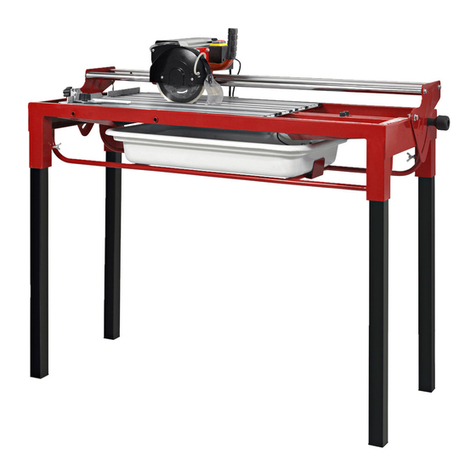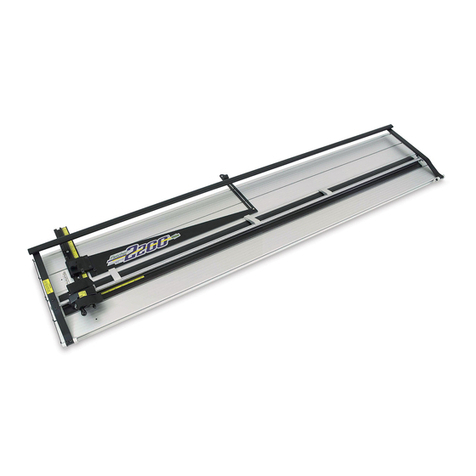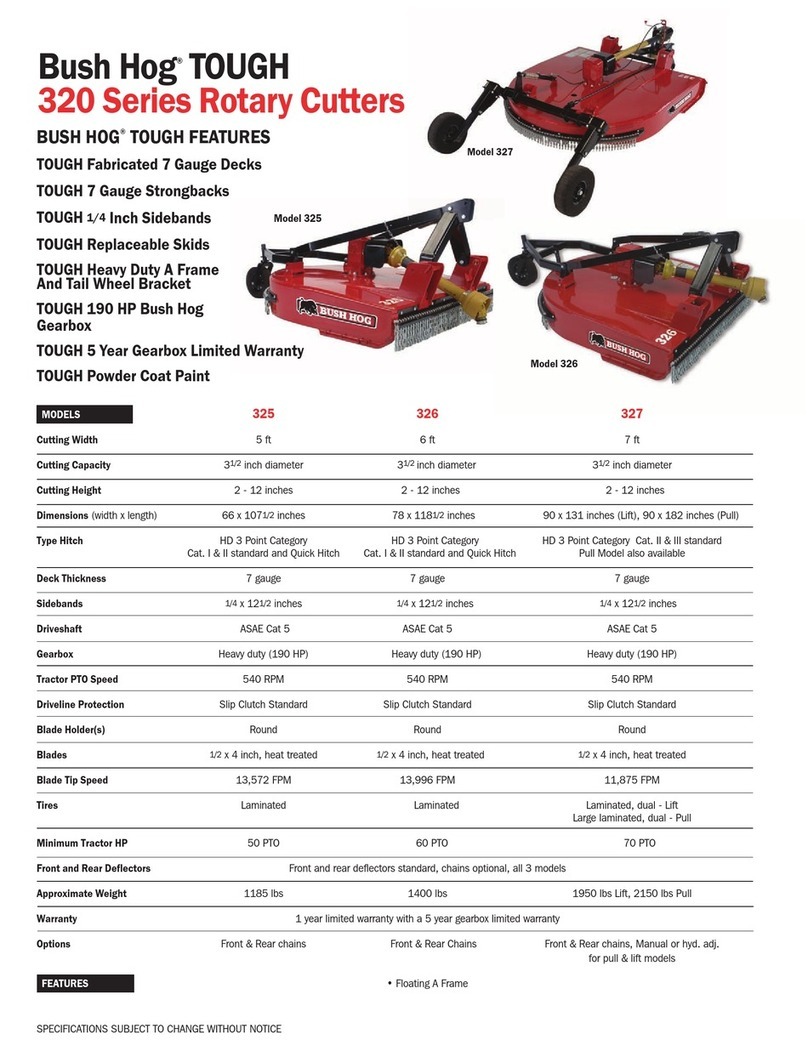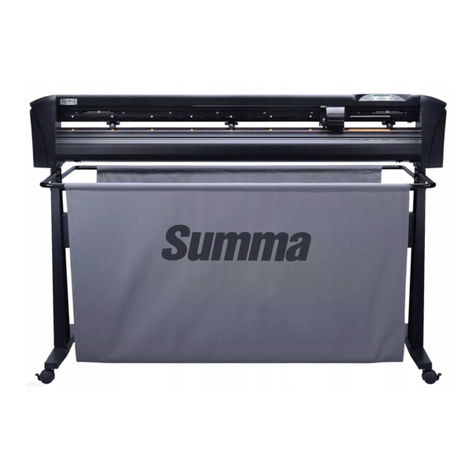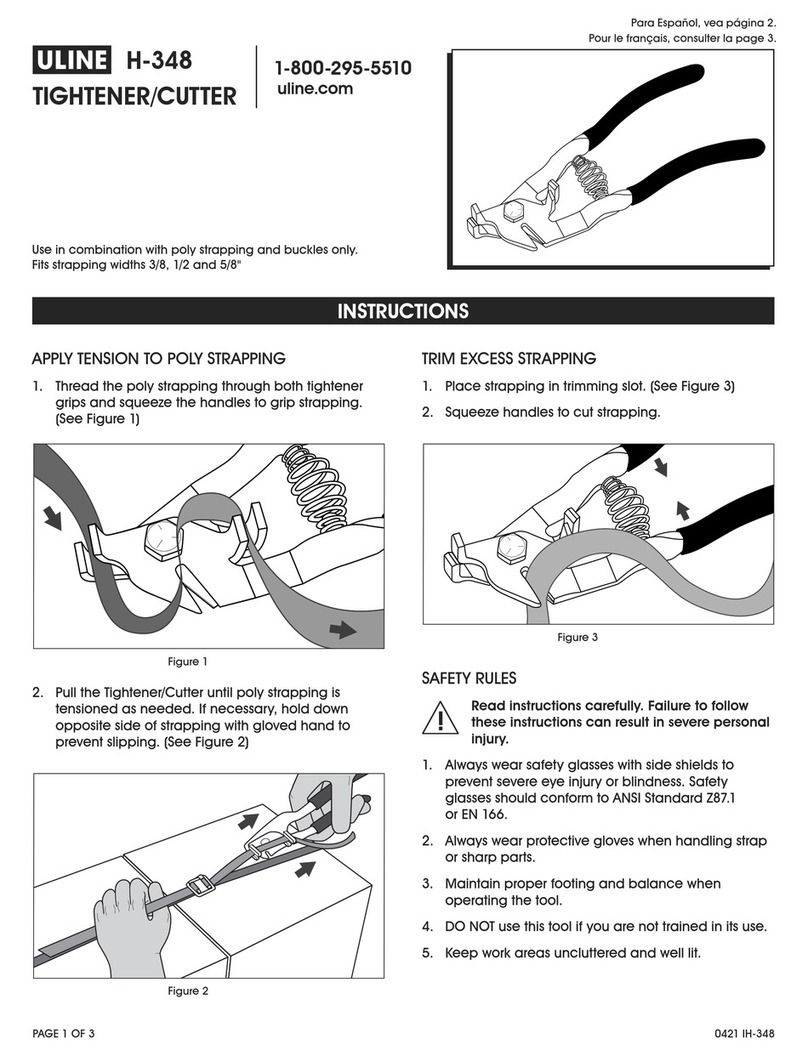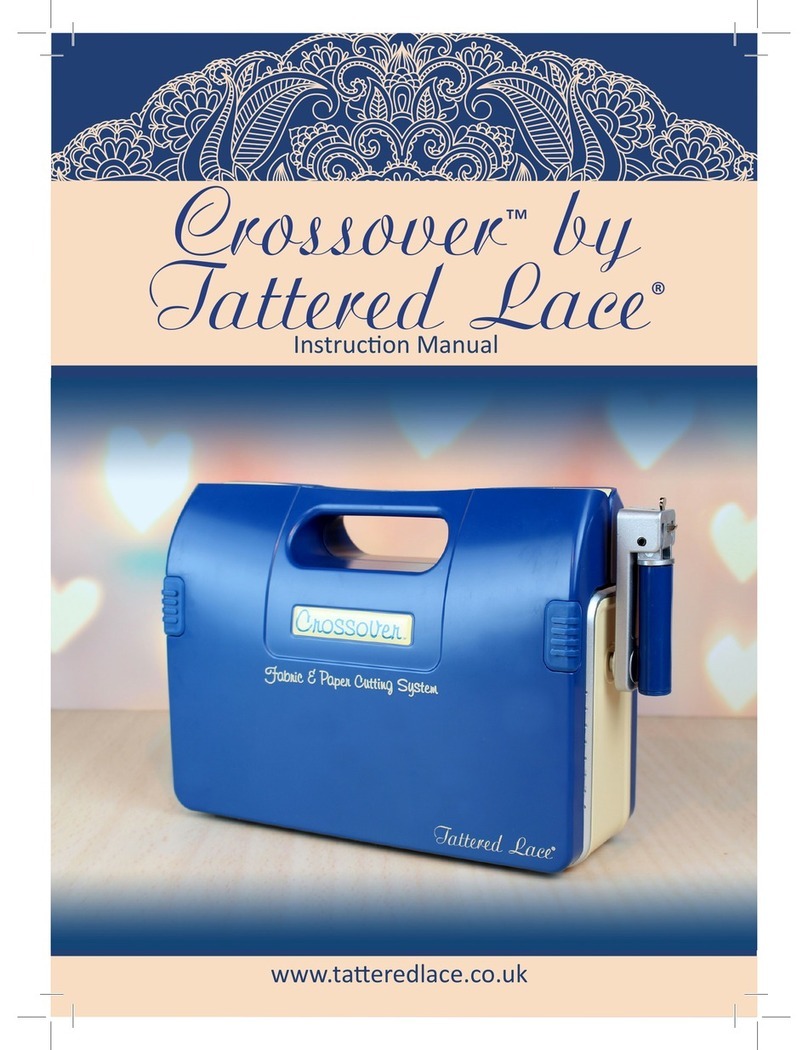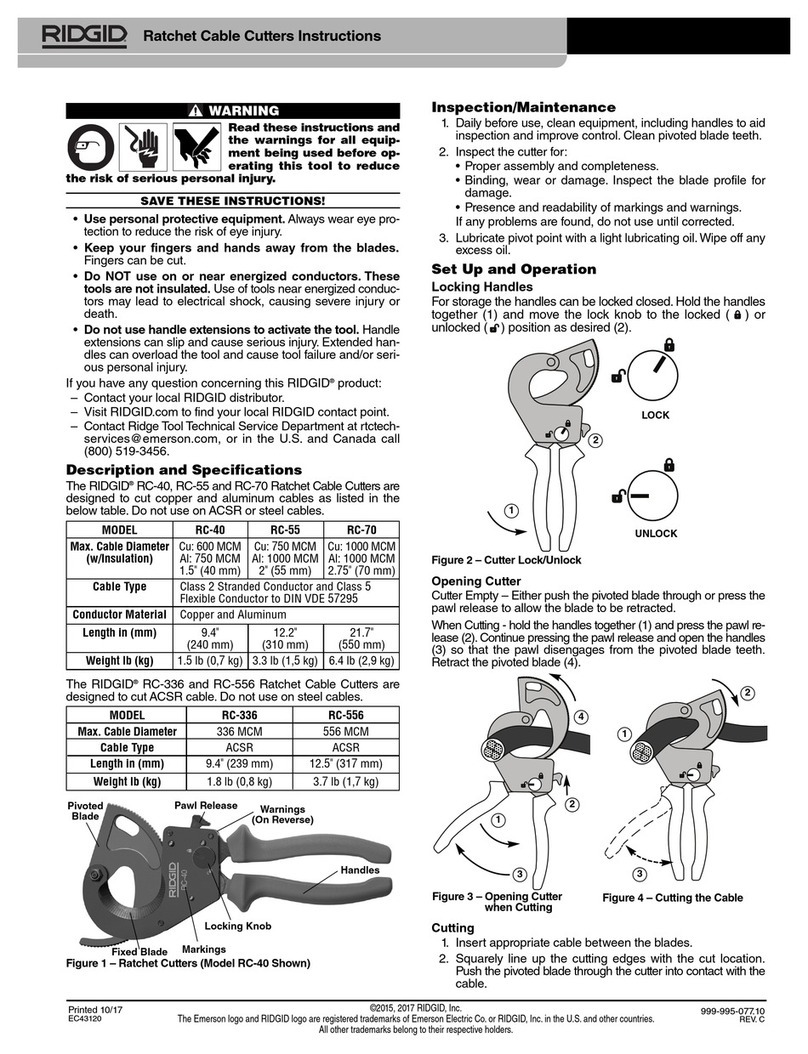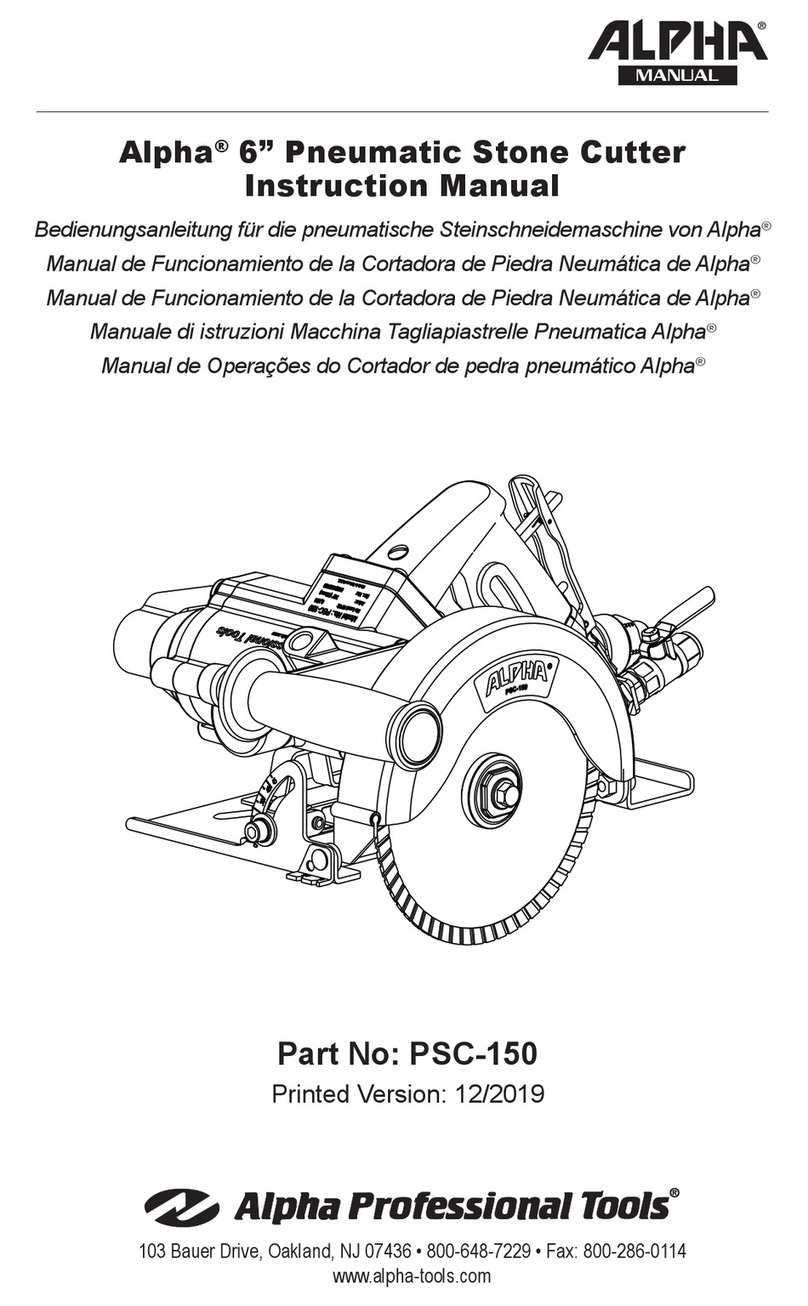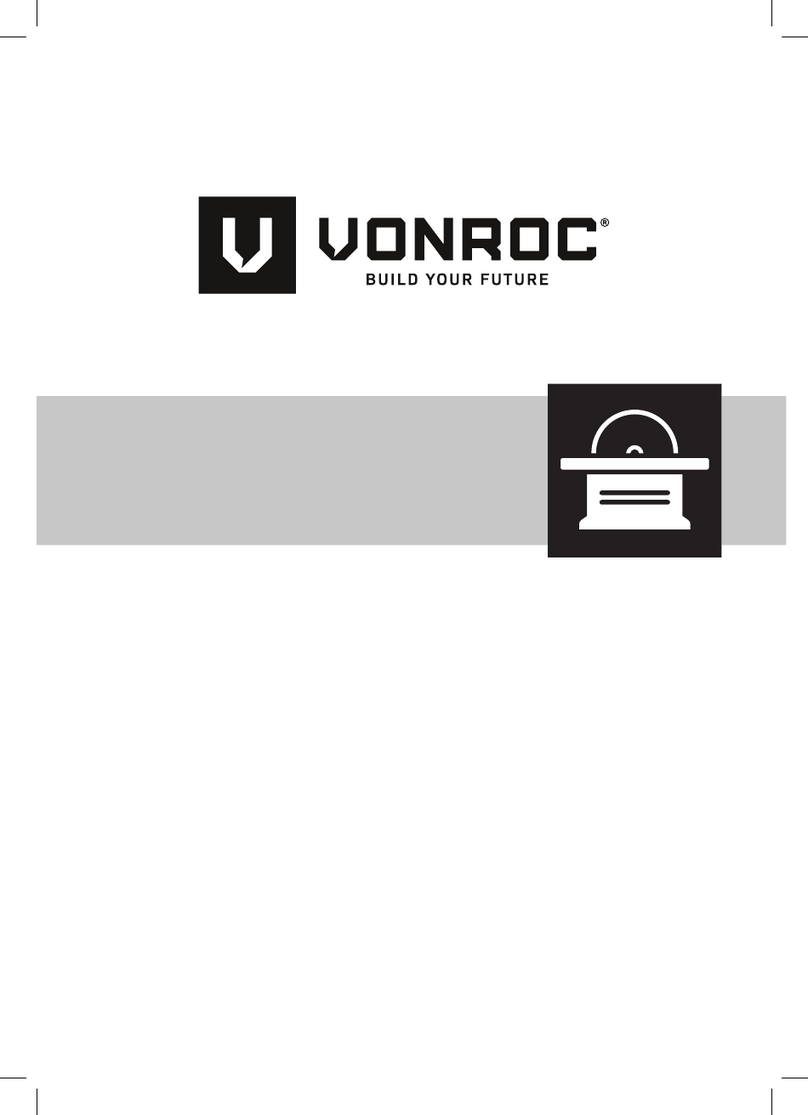Thermal Dynamics COUGAR 125 User manual

Manual No. 0-2717
July 30, 1999
Service Manual
Includes:
• 12 Amp Power Supply
• PCH-10 Torch with Leads
• Work Cable with Clamp
• Input Power Cable
For Models:
• 100 VAC 50Hz, 110 VAC 60Hz
• 120 VAC 50Hz
• 120 VAC 60Hz
• 220 VAC 50Hz
• 208/230 VAC 60Hz


Read and understand this entire manual and your employer’s
safety practices before installing, operating, or
servicing the equipment.
While the information contained in this manual represents our
best judgement, Thermal Dynamics Corporation assumes no
liability for its use.
COUGAR 125 Plasma Cutter
Service Manual Number 0-2717
Published by:
Thermal Dynamics Corporation
Industrial Park No. 2
West Lebanon, New Hampshire, USA 03784
(603) 298-5711
Copyright 1998 by
Thermal Dynamics Corporation
All rights reserved.
Reproduction of this work, in whole or in part, without written
permission of the publisher is prohibited.
The publisher does not assume and hereby disclaims any liabil-
ity to any party for any loss or damage caused by any error or
omission in the COUGAR Plasma Cutter Service Manual,
whether such error results from negligence, accident, or any
other cause.
Printed in the United States of America
July 30, 1999
WARNING
WARNING

TABLE OF CONTENTS
1: GENERAL INFORMATION ............................................................................................................... 1
1.1 Notes, Cautions and Warnings ........................................................................................ 1
1.2 Important Safety Precautions ..........................................................................................1
1.3 Publications .................................................................................................................... 2
1.4 Note, Attention et Avertissement ....................................................................................3
1.5 Precautions De Securite Importantes ............................................................................. 3
1.6 Documents De Reference................................................................................................5
1.7 Declaration of Conformity ...............................................................................................7
1.8 Statement of Warranty .................................................................................................... 8
2.0 INTRODUCTION...........................................................................................................................9
2.1 Scope Of Manual .............................................................................................................9
2.2 General Service Philosophy.............................................................................................9
2.3 Service Responsibilities..................................................................................................9
2.4 Technical Specifications ................................................................................................. 9
2.5 Dimensions .................................................................................................................. 10
3.0: SERVICE TROUBLESHOOTING .................................................................................................. 10
3.1 Introduction .................................................................................................................. 10
3.2 Periodic Inspection & Maintenance............................................................................... 10
3.3 Common Cutting Faults ................................................................................................ 10
3.4 Common Operating Problems ........................................................................................ 11
3.5 Troubleshooting Guide .................................................................................................. 11
3.6 Torch & Leads Troubleshooting ..................................................................................... 14
4.0 REPAIRS & REPLACEMENT PROCEDURES................................................................................... 14
4.1 General Information ..................................................................................................... 14
4.2 Removing Cover/Handle ............................................................................................... 15
4.3 Torch Head Assembly Replacement ............................................................................... 15
4.4 Torch Switch Only Replacement.................................................................................... 16
4.5 Capacitor Replacement ................................................................................................. 17
4.6 Control PC Board Replacement ...................................................................................... 17
4.7 Power Relay Replacement ............................................................................................. 17
4.8 ON/OFF Power Switch Replacement.............................................................................. 18
4.9 Fan Replacement .......................................................................................................... 18
4.10 Diode Bridge Rectifier Replacement ............................................................................ 18
4.11 Resistor Replacement ................................................................................................. 19
4.12 Transformer/Ferrite Core Assembly Replacement ...................................................... 19
4.13 Input Voltage Changeover (For 208/230 VAC Service Only) ......................................... 19
4.14 Torch & Leads Replacement ....................................................................................... 20
4.15 Work Cable Replacement............................................................................................. 20
4.16 Primary Input Power Cable Replacement ..................................................................... 21
5.0 PARTS LIST ............................................................................................................................... 21
5.1 Returns......................................................................................................................... 21
5.2 Power Supply Replacement Parts ................................................................................... 22
5.3 Parts Replacement ........................................................................................................ 24
5.4 Options & Accessories (not shown) ................................................................................ 24
5.5 Torch Replacement Parts .............................................................................................. 25
APPENDIX I: INTERCONNECTING DIAGRAM.................................................................................... 26

6/22/99 1 GENERAL INFORMATION
1: GENERAL
INFORMATION
1.1 Notes, Cautions and Warnings
Throughout this manual, notes, cautions, and warnings
are used to highlight important information. These high-
lights are categorized as follows:
NOTE
An operation, procedure, or background informa-
tion which requires additional emphasis or is help-
ful in efficient operation of the system.
CAUTION
A procedure which, if not properly followed, may
cause damage to the equipment.
WARNING
A procedure which, if not properly followed, may
cause injury to the operator or others in the oper-
ating area.
1.2 Important Safety Precautions
WARNING
OPERATION AND MAINTENANCE OF
PLASMA ARC EQUIPMENT CAN BE DAN-
GEROUS AND HAZARDOUS TO YOUR
HEALTH.
Plasma arc cutting produces intense electric and
magnetic emissions that may interfere with the
proper function of cardiac pacemakers, hearing
aids, or other electronic health equipment. Per-
sons who work near plasma arc cutting applica-
tions should consult their medical health profes-
sional and the manufacturer of the health
equipment to determine whether a hazard exists.
To prevent possible injury, read, understand and
follow all warnings, safety precautions and in-
structionsbeforeusing theequipment. Call1-603-
298-5711 or your local distributor if you have any
questions.
GASES AND FUMES
Gases and fumes produced during the plasma cutting
process can be dangerous and hazardous to your health.
•Keep all fumes and gases from the breathing area.
Keep your head out of the welding fume plume.
•Use an air-supplied respirator if ventilation is not
adequate to remove all fumes and gases.
•The kinds of fumes and gases from the plasma arc
depend on the kind of metal being used, coatings
on the metal, and the different processes. You must
be very careful when cutting or welding any met-
als which may contain one or more of the follow-
ing:
Antimony Chromium Mercury
Arsenic Cobalt Nickel
Barium Copper Selenium
Beryllium Lead Silver
Cadmium Manganese Vanadium
•Alwaysreadthe Material SafetyDataSheets (MSDS)
that should be supplied with the material you are
using. These MSDSs will give you the information
regarding the kind and amount of fumes and gases
that may be dangerous to your health.
•For information on how to test for fumes and gases
in your workplace, refer to item 1 in Subsection
1.3, Publications in this manual.
•Use special equipment, such as water or down draft
cutting tables, to capture fumes and gases.
•Do not use the plasma torch in an area where com-
bustibleorexplosivegasesormaterialsare located.
•Phosgene, a toxic gas, is generated from the vapors
of chlorinated solvents and cleansers. Remove all
sources of these vapors.
ELECTRIC SHOCK
Electric Shock can injure or kill. The plasma arc process
uses and produces high voltage electrical energy. This
electric energy can cause severe or fatal shock to the op-
erator or others in the workplace.
•Never touch any parts that are electrically “live”or
“hot.”
•Weardry gloves andclothing. Insulateyourself from
the work piece or other parts of the welding cir-
cuit.
•Repair or replace all worn or damaged parts.
•Extra care must be taken when the workplace is
moist or damp.

GENERAL INFORMATION 2 6/22/99
•Install and maintain equipment according to NEC
code, refer to item 9 in Subsection 1.3, Publications.
•Disconnectpowersource beforeperforming any ser-
vice or repairs.
•Read and follow all the instructions in the Operat-
ing Manual.
FIRE AND EXPLOSION
Fire and explosion can be caused by hot slag, sparks, or
the plasma arc.
•Be sure there is no combustible or flammable mate-
rial in the workplace. Any material that cannot be
removed must be protected.
•Ventilate all flammable or explosive vapors from
the workplace.
•Donotcutorweldoncontainersthat may have held
combustibles.
•Providea firewatchwhen working in an areawhere
fire hazards may exist.
•Hydrogen gas may be formed and trapped under
aluminum workpieces when they are cut under-
water or while using a water table. DO NOT cut
aluminum alloys underwater or on a water table
unless the hydrogen gas can be eliminated or dis-
sipated. Trapped hydrogen gas that is ignited will
cause an explosion.
NOISE
Noisecancausepermanent hearing loss. Plasma arcpro-
cesses can cause noise levels to exceed safe limits. You
must protect your ears from loud noise to prevent per-
manent loss of hearing.
•To protect your hearing from loud noise, wear pro-
tective ear plugs and/or ear muffs. Protect others
in the workplace.
•Noise levels should be measured to be sure the deci-
bels (sound) do not exceed safe levels.
•For information on how to test for noise, see item 1
in Subsection 1.3, Publications, in this manual.
PLASMAARC RAYS
PlasmaArcRays can injureyour eyes and burnyourskin.
The plasma arc process produces very bright ultra violet
and infra red light. These arc rays will damage your
eyesandburn your skinifyou arenot properlyprotected.
•To protect your eyes, always wear a welding hel-
metorshield. Alsoalways wear safety glasses with
side shields, goggles or other protective eye wear.
•Wear welding gloves and suitable clothing to pro-
tect your skin from the arc rays and sparks.
•Keep helmet and safety glasses in good condition.
Replace lenses when cracked, chipped or dirty.
•Protect others in the work area from the arc rays.
Use protective booths, screens or shields.
•Use the shade of lens as suggested in the following
per ANSI/ASC Z49.1:
Minimum Protective Suggested
Arc Current Shade No. Shade No.
Less Than 300* 8 9
300 - 400* 9 12
400 - 800* 10 14
* Thesevaluesapplywhere the actualarcisclearly
seen. Experience has shown that lighter filters
may be used when the arc is hidden by the work-
piece.
1.3 Publications
Refer to the following standards or their latest revisions
for more information:
1. OSHA, SAFETY AND HEALTH STANDARDS,
29CFR 1910, obtainable from the Superintendent of
Documents, U.S. Government Printing Office, Wash-
ington, D.C. 20402
2. ANSI Standard Z49.1, SAFETY IN WELDING AND
CUTTING, obtainable from the American Welding
Society, 550 N.W. LeJeune Rd, Miami, FL 33126
3. NIOSH, SAFETY AND HEALTH IN ARC WELD-
INGAND GAS WELDING AND CUTTING, obtain-
able from the Superintendent of Documents, U.S.
GovernmentPrinting Office,Washington, D.C. 20402
4. ANSI Standard Z87.1, SAFE PRACTICES FOR OC-
CUPATIONAND EDUCATIONAL EYEAND FACE
PROTECTION, obtainable from American National
Standards Institute, 1430 Broadway, New York, NY
10018
5. ANSI Standard Z41.1, STANDARD FOR MEN’S
SAFETY-TOE FOOTWEAR, obtainable from the
American National Standards Institute, 1430 Broad-
way, New York, NY 10018
6. ANSI Standard Z49.2, FIRE PREVENTION IN THE
USE OF CUTTING AND WELDING PROCESSES,
obtainable fromAmerican National Standards Insti-
tute, 1430 Broadway, New York, NY 10018
7. AWS Standard A6.0, WELDING AND CUTTING
CONTAINERS WHICH HAVE HELD COMBUS-
TIBLES, obtainable fromAmerican Welding Society,
550 N.W. LeJeune Rd, Miami, FL 33126

6/22/99 3 GENERAL INFORMATION
8. NFPA Standard 51, OXYGEN-FUEL GAS SYSTEMS
FOR WELDING, CUTTING AND ALLIED PRO-
CESSES, obtainable from the National Fire Protection
Association, Batterymarch Park, Quincy, MA 02269
9. NFPAStandard 70,NATIONALELECTRICALCODE,
obtainable from the National Fire Protection Asso-
ciation, Batterymarch Park, Quincy, MA 02269
10. NFPA Standard 51B, CUTTING AND WELDING
PROCESSES, obtainable from the National Fire Pro-
tection Association, Batterymarch Park, Quincy, MA
02269
11. CGA Pamphlet P-1, SAFE HANDLING OF COM-
PRESSED GASES IN CYLINDERS, obtainable from
the Compressed Gas Association, 1235 Jefferson
Davis Highway, Suite 501, Arlington, VA22202
12. CSA Standard W117.2, CODE FOR SAFETY IN
WELDINGAND CUTTING, obtainable from the Ca-
nadian Standards Association, Standards Sales, 178
Rexdale Boulevard, Rexdale, Ontario, Canada M9W
1R3
13. NWSA booklet, WELDING SAFETY BIBLIOGRA-
PHY obtainable from the National Welding Supply
Association, 1900Arch Street, Philadelphia, PA19103
14. American Welding Society StandardAWSF4.1, REC-
OMMENDED SAFE PRACTICES FOR THE PREPA-
RATION FOR WELDINGAND CUTTING OF CON-
TAINERS AND PIPING THAT HAVE HELD
HAZARDOUS SUBSTANCES, obtainable from the
American Welding Society, 550 N.W. LeJeune Rd,
Miami, FL 33126
15. ANSI Standard Z88.2, PRACTICE FOR RESPIRA-
TORY PROTECTION, obtainable from American
National Standards Institute, 1430 Broadway, New
York, NY 10018
1.4 Note, Attention et
Avertissement
Dans ce manuel, les mots “note,”“attention,”et
“avertissement”sont utilisés pour mettre en relief des
informations àcaractère important. Ces mises en relief
sont classifiées comme suit :
NOTE
Toute opération, procédure ou renseignement
général sur lequel il importe d’insister davantage
ou qui contribue à l’efficacité de fonctionnement
du système.
ATTENTION
Toute procédure pouvant résulter
l’endommagement du matériel en cas de non-
respect de la procédure en question.
AVERTISSEMENT
Toute procédure pouvant provoquer des blessures
de l’opérateur ou des autres personnes se trouvant
dans la zone de travail en cas de non-respect de la
procédure en question.
1.5 Precautions De Securite
Importantes
AVERTISSEMENT
L’OPÉRATION ET LA MAINTENANCE DU
MATÉRIEL DE SOUDAGE À L’ARC AU JET
DE PLASMA PEUVENT PRÉSENTER DES
RISQUES ET DES DANGERS DE SANTÉ.
Coupantàl’arc aujetde plasma produitde l’énergie
électrique haute tension et des émissions
magnétique qui peuvent interférer la fonction
propre d’un “pacemaker” cardiaque, les appareils
auditif, ou autre matériel de santé electronique.
Ceux qui travail près d’une application à l’arc au
jet de plasma devrait consulter leur membre
professionel de médication et le manufacturier de
matériel de santé pour déterminer s’il existe des
risques de santé.
Il faut communiquer aux opérateurs et au person-
nel TOUS les dangers possibles. Afin d’éviter les
blessures possibles, lisez, comprenez et suivez tous
lesavertissements, toutes lesprécautionsdesécurité
et toutes les consignes avant d’utiliser le matériel.
Composez le + 603-298-5711 ou votre distributeur
local si vous avez des questions.
FUMÉE et GAZ
La fumée et les gaz produits par le procédéde jet de
plasma peuvent présenter des risques et des dangers de
santé.
•Eloignez toute fumée et gaz de votre zone de respi-
ration. Gardez votre tête hors de la plume de fumée
provenant du chalumeau.
•Utilisez un appareil respiratoire àalimentation en
air si l’aération fournie ne permet pas d’éliminer la
fumée et les gaz.
•Les sortes de gaz et de fumée provenant de l’arc de
plasma dépendent du genre de métal utilisé, des
revêtementsse trouvantsur le métalet des différents

GENERAL INFORMATION 4 6/22/99
procédés. Vous devez prendre soin lorsque vous
coupez ou soudez tout métal pouvant contenir un
ou plusieurs des éléments suivants:
antimoine cadmium mercure
argent chrome nickel
arsenic cobalt plomb
baryum cuivre sélénium
béryllium manganèse vanadium
•Lisez toujours les fiches de données sur la sécurité
des matières (sigle américain “MSDS”); celles-ci
devraient être fournies avec le matériel que vous
utilisez. Les MSDS contiennent des renseignements
quant àla quantitéet la nature de la fumée et des
gaz pouvant poser des dangers de santé.
•Pour des informations sur la manière de tester la
fumée et les gaz de votre lieu de travail, consultez
l’article 1 et les documents cités àla page 4.
•Utilisez un équipement spécial tel que des tables de
coupe àdébit d’eau ou àcourant descendant pour
capter la fumée et les gaz.
•N’utilisez pas le chalumeau au jet de plasma dans
une zone oùse trouvent des matières ou des gaz
combustibles ou explosifs.
•Le phosgène, un gaz toxique, est générépar la fumée
provenantdes solvants et des produitsde nettoyage
chlorés. Eliminez toute source de telle fumée.
CHOC ELECTRIQUE
Les chocs électriques peuvent blesser ou même tuer. Le
procédéau jet de plasma requiert et produit de l’énergie
électrique haute tension. Cette énergie électrique peut
produiredes chocs graves, voiremortels, pour l’opérateur
et les autres personnes sur le lieu de travail.
•Ne touchez jamais une pièce “sous tension”ou
“vive”; portez des gants et des vêtements secs.
Isolez-vous de la pièce de travail ou des autres par-
ties du circuit de soudage.
•Réparez ou remplacez toute pièce usée ou
endommagée.
•Prenez des soins particuliers lorsque la zone de tra-
vail est humide ou moite.
•Montez et maintenez le matériel conformément au
Code électrique national des Etats-Unis. (Voir la
page 4, article 9.)
•Débranchez l’alimentation électrique avant tout tra-
vail d’entretien ou de réparation.
•Lisez et respectez toutes les consignes du Manuel
de consignes.
INCENDIE ET EXPLOSION
Lesincendies et lesexplosionspeuvent résulterdes scories
chaudes, des étincelles ou de l’arc de plasma. Le procédé
àl’arc de plasma produit du métal, des étincelles, des
scories chaudes pouvant mettre le feu aux matières com-
bustibles ou provoquer l’explosion de fumées
inflammables.
•Soyez certain qu’aucune matière combustible ou in-
flammable ne se trouve sur le lieu de travail.
Protégez toute telle matière qu’il est impossible de
retirer de la zone de travail.
•Procurez une bonne aération de toutes les fumées
inflammables ou explosives.
•Necoupezpasetnesoudezpas les conteneurs ayant
pu renfermer des matières combustibles.
•Prévoyez une veille d’incendie lors de tout travail
dans une zone présentant des dangers d’incendie.
•Le gas hydrogène peut se former ou s’accumuler
sous les pièces de travail en aluminium lorsqu’elles
sont coupées sous l’eau ou sur une table d’eau. NE
PAS couper les alliages en aluminium sous l’eau ou
sur une table d’eau àmoins que le gas hydrogène
peut s’échapper ou se dissiper. Le gas hydrogène
accumuléexplosera si enflammé.
RAYONS D’ARC DE PLASMA
Les rayons provenant de l’arc de plasma peuvent blesser
vosyeuxet brûlervotrepeau. Leprocédéàl’arcde plasma
produit une lumière infra-rouge et des rayons ultra-vio-
lets très forts. Ces rayons d’arc nuiront àvos yeux et
brûleront votre peau si vous ne vous protégez pas
correctement.
•Pour protéger vos yeux, portez toujours un casque
ouunécran desoudeur. Portez toujoursdeslunettes
de sécuritémunies de parois latérales ou des lu-
nettes de protection ou une autre sorte de protec-
tion oculaire.
•Portez des gants de soudeur et un vêtement
protecteur appropriépour protéger votre peau
contre les étincelles et les rayons de l’arc.
•Maintenez votre casque et vos lunettes de protec-
tion en bon état. Remplacez toute lentille sale ou
comportant fissure ou rognure.
•Protégez les autres personnes se trouvant sur la zone
de travail contre les rayons de l’arc en fournissant
des cabines ou des écrans de protection.

6/22/99 5 GENERAL INFORMATION
•Use the shade of lens as suggested in the following
chart per ANSI/ASC Z49.1:
•Utilisez la nuance de lentille qui est suggèrée dans
le recommendation qui suivent ANSI/ASC Z49.1:
Nuance Minimum Nuance Suggerée
Courant Arc Protective Numéro Numéro
Moins de 300* 8 9
300 - 400* 9 12
400 - 800* 10 14
*Cesvaleurs s’appliquent oul’arcactuelestobservé
clairement. L’experience a démontrer que les filtres
moins foncés peuvent être utilisés quand l’arc est
caché par moiceau de travail.
BRUIT
Le bruit peut provoquer une perte permanente de l’ouïe.
Les procédés de soudage àl’arc de plasma peuvent
provoquer des niveaux sonores supérieurs aux limites
normalement acceptables. Vous dú4ez vous protéger les
oreilles contre les bruits forts afin d’éviter une perte
permanente de l’ouïe.
•Pourprotégervotreouïecontrelesbruits forts,portez
des tampons protecteurs et/ou des protections
auriculaires. Protégez également les autres
personnes se trouvant sur le lieu de travail.
•Il faut mesurer les niveaux sonores afin d’assurer
que les décibels (le bruit) ne dépassent pas les
niveaux sûrs.
•Pour des renseignements sur la manière de tester le
bruit, consultez l’article 1, page 5.
1.6 Documents De Reference
Consultez les normes suivantes ou les révisions les plus
récentes ayant étéfaites àcelles-ci pour de plus amples
renseignements :
1. OSHA, NORMES DE SÉCURITÉDU TRAVAIL ET
DE PROTECTION DE LA SANTÉ, 29CFR 1910,
disponible auprès du Superintendent of Docu-
ments, U.S. Government Printing Office, Washing-
ton, D.C. 20402
2. Norme ANSI Z49.1, LA SÉCURITÉDES
OPÉRATIONS DE COUPE ET DE SOUDAGE,
disponible auprès de la SociétéAméricaine de
Soudage (American Welding Society), 550 N.W.
LeJeune Rd., Miami, FL 33126
3. NIOSH, LA SÉCURITÉET LA SANTÉLORS DES
OPÉRATIONS DE COUPE ET DE SOUDAGE À
L’ARC ETAU GAZ, disponible auprès du Superin-
tendent of Documents, U.S. Government Printing
Office, Washington, D.C. 20402
4. Norme ANSI Z87.1, PRATIQUES SURES POUR LA
PROTECTION DES YEUX ET DU VISAGE AU
TRAVAIL ET DANS LES ECOLES, disponible de
l’InstitutAméricaindes Normes Nationales (Ameri-
can National Standards Institute), 1430 Broadway,
New York, NY 10018
5. Norme ANSI Z41.1, NORMES POUR LES
CHAUSSURESPROTECTRICES,disponible auprès
de l’American National Standards Institute, 1430
Broadway, New York, NY 10018
6. Norme ANSI Z49.2, PRÉVENTION DES
INCENDIES LORS DE L’EMPLOI DE PROCÉDÉS
DE COUPE ET DE SOUDAGE, disponible auprès
de l’American National Standards Institute, 1430
Broadway, New York, NY 10018
7. Norme A6.0 de l’Association Américaine du
Soudage (AWS), LE SOUDAGE ET LACOUPE DE
CONTENEURS AYANT RENFERMÉDES
PRODUITSCOMBUSTIBLES,disponibleauprès de
laAmericanWelding Society, 550 N.W.LeJeuneRd.,
Miami, FL 33126
8. Norme 51 de l’AssociationAméricaine pour la Pro-
tectioncontreles Incendies(NFPA),LES SYSTEMES
ÀGAZ AVEC ALIMENTATION EN OXYGENE
POUR LE SOUDAGE, LA COUPE ET LES
PROCÉDÉSASSOCIÉS,disponible auprèsde laNa-
tional Fire Protection Association, Batterymarch
Park, Quincy, MA 02269
9. Norme 70 de la NFPA, CODE ELECTRIQUE NA-
TIONAL,disponibleauprès de laNationalFirePro-
tectionAssociation,BatterymarchPark, Quincy, MA
02269
10. Norme 51B de la NFPA, LES PROCÉDÉS DE
COUPE ET DE SOUDAGE, disponible auprès de
la National Fire Protection Association,
Batterymarch Park, Quincy, MA 02269
11. Brochure GCA P-1, LA MANIPULATION SANS
RISQUE DES GAZ COMPRIMÉS EN CYLINDRES,
disponible auprès de l’Association des Gaz
Comprimés (Compressed Gas Association), 1235
Jefferson Davis Highway, Suite 501, Arlington, VA
22202
12. Norme CSAW117.2, CODE DE SÉCURITÉPOUR
LE SOUDAGE ET LA COUPE, disponible auprès
de l’Association des Normes Canadiennes, Stan-
dards Sales, 178 Rexdale Boulevard, Rexdale,
Ontario, Canada, M9W 1R3
13.ivretNWSA, BIBLIOGRAPHIE SURLASÉCURITÉ
DU SOUDAGE, disponible auprès de l’Association
Nationale de Fournitures de Soudage (National
Welding Supply Association), 1900 Arch Street,
Philadelphia, PA 19103

GENERAL INFORMATION 6 6/22/99
14. Norme AWSF4.1 de l’Association Américaine de
Soudage,RECOMMANDATIONS DE PRATIQUES
SURESPOURLAPRÉPARATIONÀLACOUPE ET
AU SOUDAGE DE CONTENEURS ET TUYAUX
AYANT RENFERMÉDES PRODUITS
DANGEREUX , disponible auprès de la American
Welding Society, 550 N.W. LeJeune Rd., Miami, FL
33126
15. Norme ANSI Z88.2, PRATIQUES DE PROTEC-
TION RESPIRATOIRE, disponible auprès de
l’American National Standards Institute, 1430
Broadway, New York, NY 10018

6/22/99 7 GENERAL INFORMATION
1.7 Declaration of Conformity
Manufacturer: Thermal Dynamics Corporation
Address: Industrial Park #2
West Lebanon, New Hampshire 03784
USA
The equipment described in this manual conforms to all applicable aspects and regulations of the ‘Low Voltage Direc-
tive’(European Council Directive 73/23/EEC as amended by Council Directive 93/68/EEC) and to the National
legislation for the enforcement of this Directive.
Serialnumbersareuniquewitheachindividual piece of equipment and details description, parts used to manufacture
a unit and date of manufacture.
National Standard and Technical Specifications
The product is designed and manufactured to a number of standards and technical requirements among them are:
* CSA(Canadian StandardsAssociation) standard C22.2 number 60 forArc welding equipment.
* UL(Underwriters Laboratory) rating 94VO flammability testing for all printed-circuit boards used.
* ISO/IEC 60974-1 (BS 638-PT10) (EN 60 974-1) (EN50192) (EN50078) applicable to plasma cutting equipment and associ-
ated accessories.
* Extensive product design verification is conducted at the manufacturing facility as part of the routine design and
manufacturing process. This is to ensure the product is safe, when used according to instructions in this manual and
related industry standards, and performs as specified. Rigorous testing is incorporated into the manufacturing
process to ensure the manufactured product meets or exceeds all design specifications.
Thermal Dynamics has been manufacturing products for more than 30 years, and will continue to achieve excellence in our
area of manufacture.
Manufacturers responsible representative: Steve Ward
Director of Operations
ThermadyneUK
ChorleyEngland

GENERAL INFORMATION 8 6/22/99
1.8 Statement of Warranty
LIMITED WARRANTY: Thermal Dynamics®Corporation (hereinafter “Thermal”) warrants that its products will be free of defects in
workmanship or material. Should any failure to conform to this warranty appear within the time period applicable to the Thermal
products as stated below, Thermal shall, upon notification thereof and substantiation that the product has been stored, installed, operated,
and maintained in accordance with Thermal’s specifications, instructions, recommendations and recognized standard industry practice,
and not subject to misuse, repair, neglect, alteration, or accident, correct such defects by suitable repair or replacement, at Thermal’s sole
option, of any components or parts of the product determined by Thermal to be defective.
THIS WARRANTY IS EXCLUSIVE AND IS IN LIEU OF ANY WARRANTY OF MERCHANTABILITY OR FITNESS FOR A
PARTICULAR PURPOSE.
LIMITATION OF LIABILITY: Thermal shall not under any circumstances be liable for special or consequential damages, such as, but
not limited to, damage or loss of purchased or replacement goods, or claims of customers of distributor (hereinafter “Purchaser”) for
service interruption. The remedies of the Purchaser set forth herein are exclusive and the liability of Thermal with respect to any
contract, or anything done in connection therewith such as the performance or breach thereof, or from the manufacture, sale, delivery,
resale, or use of any goods covered by or furnished by Thermal whether arising out of contract, negligence, strict tort, or under any
warranty, or otherwise, shall not, except as expressly provided herein, exceed the price of the goods upon which such liability is based.
THIS WARRANTY BECOMES INVALID IF REPLACEMENT PARTS OR ACCESSORIES ARE USED WHICH MAY IMPAIR THE
SAFETY OR PERFORMANCE OF ANY THERMAL PRODUCT.
THIS WARRANTY IS INVALID IF THE PRODUCT IS SOLD BY NON-AUTHORIZED PERSONS.
The limited warranty periods for Thermal products shall be as follows (with the exception of XL Plus Series, CutMaster 80XL , Cougar
and DRAG-GUN): Amaximum of three (3) years from date of sale to an authorized distributor and a maximum of two (2) years from
date of sale by such distributor to the Purchaser, and with the further limitations on such two (2) year period (see chart below).
The limited warranty period for XL Plus Series and CutMaster 80XL shall be as follows: Amaximum of four (4) years from date
of sale to an authorized distributor and a maximum of three (3) years from date of sale by such distributor to the Purchaser, and
with the further limitations on such three (3) year period (see chart below).
The limited warranty period for Cougar and DRAG-GUN shall be as follows: Amaximum of two (2) years from date of sale to an
authorized distributor and a maximum of one (1) year from date of sale by such distributor to the Purchaser, and with the further
limitations on such two (2) year period (see chart below).
Parts
XL Plus Series & Parts Parts
PAK Units, Power Supplies CutMaster 80XL Cougar/Drag-Gun All Others Labor
Main Power Magnetics 3 Years 1 Year 2 Years 1 Year
Original Main Power Rectifier 3 Years 1 Year 2 Years 1 Year
Control PC Board 3 Years 1 Year 2 Years 1 Year
All Other Circuits And Components Including, 1 Year 1 Year 1 Year 1 Year
But Not Limited To, Starting Circuit,
Contactors, Relays, Solenoids, Pumps,
Power Switching Semi-Conductors
Consolles, Control Equipment, Heat 1 Year 1 Year 1 Year
Exchanges, And Accessory Equipment
Torch And Leads
Maximizer 300 Torch 1 Year 1 Year
All Other Torches 180 Days 180 Days 180 Days 180 Days
Repair/Replacement Parts 90 Days 90 Days 90 Days None
Warranty repairs or replacement claims under this limited warranty must be submitted by an authorized Thermal Dynamics®repair
facility within thirty (30) days of the repair. No transportation costs of any kind will be paid under this warranty. Transportation
charges to send products to an authorized warranty repair facility shall be the responsibility of the customer. All returned goods shall
be at the customer’s risk and expense. This warranty supersedes all previous Thermal warranties.
Effective May 6, 1999

ServiceManual 0-2717 9 COUGAR125 PlasmaCutter
2.3 Service Responsibilities
The Service Technician should be familiar with the equip-
ment and its capabilities and should be prepared to rec-
ommend arrangements of components which will pro-
vide the most efficient layout, utilizing the equipment to
its best possible advantage.
Maintenance work should be accomplished in a timely
manner. If problems are encountered, or the equipment
does not function as specified, contact Technical Services
Department in West Lebanon for assistance.
2.4 Technical Specifications
A. System Specifications
System Specifications
Input/Output
Specifications Seesubsection2.4B
Duty Cycle Seesubsection2.4B
Maximum OCV 280 VDC
PilotCircuitry Capacitive Discharge (CD), Constant DC
Weightwith Leads 52 lbs(24 kg)
Power Supply L 16 in. (406 mm)
Dimensions W 9 in. (229 mm)
H 10 in. (254 mm)
Work Cable 15 ft. (4.6 m)
InputPower Cable 6.6ft. (2 m) minimum
Torch Style PCH-10 70°
Torch Dimensions L 8 in. (203 mm)
W 3 in. (75mm)
Cutting Rating 12 Amps Max. StraightPolarity
Duty Cycle 100% @ 12 amps on 1/8 in. (3.2 mm) metal
Cutting Range 28 ga. (.5mm) - 10 ga.(3 mm) carbon steel
Severance Mostmetalsup to 3/16 in. (4.8 mm)
Pierce Rating 1/16 in. (1.6 mm)
Transfer Distance Approx. 1/8 in. (3.2 mm)
Gas Requirements Type: Compressed Air (External)
Operating Pressure: 25 psi (1.7 bar)
Flow: 60-80 scfh @25 psi (see note below)
(28.3-38 lpm@ 1.7 bar)
Leads Length 20 ft. (6.1 m)
2.0 INTRODUCTION
2.1 Scope Of Manual
This manual provides service instructions for the Ther-
mal Dynamics®COUGAR 125 Plasma Cutter.
Information in this edition is particularly applicable to
the Troubleshooting and Repair of the equipment, and is
intended for use by properly trained Service Technicians
familiar with this equipment.
Read this manual and the COUGAR 125 Operating
Manual, 0-2716, thoroughly. A complete understanding
of the capabilities and functions of the equipment will
assure obtaining the performance for which it was de-
signed.
2.2 General Service Philosophy
Several key points are essential to properly support the
application and operation of this equipment.
A. Application
The equipment should satisfy the customer’s require-
ments as supplied and as described in Section 3 of this
manual. Be sure to confirm that the equipment is capable
of the application desired.
B. Modifications
No physical or electrical modifications other than selec-
tion of standard options and accessories are to be made
to this equipment.
C. Customer/Operator Responsibilities
It is the customer/operator's responsibility to maintain
the equipment and peripheral accessories provided by
ThermalDynamicsin good operating orderinaccordance
with the procedures outlined in the Operating Manual,
and to protect the equipment from accidental or mali-
cious damage.
D. Repair Restrictions
Theelectronicsconsists of a Printed CircuitBoardAssem-
bly which must be carefully handled, and must be re-
placed as a unit. No replacement of printed circuit sol-
der-mounted components is allowed except as noted in
this manual. If PC Board is to be returned, the replaced
Printed Circuit Board Assembly must be properly pack-
aged in protective material and returned intact per nor-
mal procedures.
NOTE
Customer-suppliedCompressorshouldsupply 150-
200 scfh @ 50 PSI (3.5 bar)

COUGAR125 PlasmaCutter 10 ServiceManual 0-2717
B. Input/Output Specifications
Model Hz Input
Amps
RMS
Output
Amps
(DC)
Output
Voltage
(DC)
Duty
Cycle %
100/110V 50/60 25/24 12 85 30
120V 50 22 12 95 30
120V 60 20 12 70 30
220V 50 13 12 85 30
208/230V 60 10 12 78 30
2.5 Dimensions
16.0 in
(406 mm) 9.0 in
(229 mm)
10.0 in.
(254 mm)
A-02235
Figure 2-1 Power Supply Dimensions
A-02006
7.98 in (203 mm)
1.06 in (27 mm)
2.95 in
(75 mm)
Figure 2-4 Torch Dimensions
3.0: SERVICE
TROUBLESHOOTING
3.1 Introduction
This section provides service diagnostics for the COU-
GAR 125 Plasma Cutter with PCH-10 Torch, aiding the
technician to isolate faulty subassemblies.
Under no circumstances are field repairs to be attempted
on Printed Circuit Boards or other subassemblies of this
unit. Evidence of unauthorized repairs will void the fac-
tory warranty.
WARNING
There are extremely dangerous voltage and power
levels present inside this unit. Do not attempt to
diagnose or repair unless you have had training in
power electronics measurement and troubleshoot-
ing techniques.
3.2 Periodic Inspection &
Maintenance
The COUGAR 125 Operating Manual 0-2716, describes
theinspectionand maintenance procedureswhich should
be performed at periodic intervals. Routine Maintenance
ensures optimumperformanceofequipment and can pre-
ventthe user fromencounteringproblemswiththisequip-
ment. Refer to that manual for instructions on power
supply and torch maintenance.
3.3 Common Cutting Faults
Poor or lackluster performance can often be improved
by slight modifications to technique or equipment. For
example:
A. Insufficient Penetration
1. Cutting speed too fast
2. Torch tilted too much
3. Metal too thick
4. Worn torch parts
5. Standoff too high
6. Line voltage too low
7. Extension cord with inadequate rating
B. Main Arc Extinguishes
1. Cutting speed too slow
2. Torch standoff too high from workpiece
3. Work cable disconnected
4. Worn torch parts
C. Excessive Dross Formation
1. Cutting speed too slow
2. Torch standoff too high from workpiece
3. Worn torch parts

ServiceManual 0-2717 11 COUGAR125 PlasmaCutter
D. Short Torch Parts Life
1. Exceeding system capability (material too thick)
2. Excessive pilot arc time
3. Improperly assembled torch
4. Incorrect gas pressure/flow
5. Ground or work lead not connected
3.4 Common Operating
Problems
Gettingusedto the waythesystem sounds andfeelswhile
it is operating properly will help to determine the nature
of problems if they arise.
A. Power Source Related
If the available 120V service is saggy, pilot and cut per-
formance will be degraded. In some cases, the service
circuit breaker may open during use. Some things that
will help:
•Use a service fused or circuit breaker for correct
amperage (Refer to Operator Manual 0-2716, sub-
section 4.0-D for service amperage.)
•Use heavy gauge extension cords (Refer to Operat-
ing Manual 0-2716 for sizes).
•Use as short an extension cord as possible.
•Try different outlets on different branch circuits. Use
the one that gives the strongest pilot.
B. Power Supply/Torch Related
In some instances when the torch switch is pressed there
is no pilot. You may need to try several times before the
torch fires.
If the torch does not fire (no pilot arc) soon after the torch
switch is activated, try releasing the torch switch and let-
tingthe leads bleeddownbeforetrying again. This should
help because the torch fires best at a lower voltage with
lower air pressure at the torch.
C. Cutting Related
1. Piloting
One of the features of this plasma cutter is the con-
stant DC pilot. This means the plasma arc is always
“on”- either as a pilot arc, or a cutting arc, resulting in
averysmooth,forgivingsystem. This also means that
the torch tip will wear fairly rapidly if you pilot for
an extended time or cut with too great a standoff (es-
sentiallyswitchingfroma transferredcuttingarcback
to the constant DC pilot arc).
The best way to prevent this is to pilot for no more
than 5 seconds at a time (or start with the torch in
contact with the material) and “drag cut”, that is, hold
the tip in direct contact with the material to be cut.
For some materials, holding a slight standoff (1/
16")(1.6 mm) may provide a better cut.
NOTE
Piloting is harder on parts life than actual cutting
because the pilot arc is directed from the electrode
to the tip rather than to a workpiece. Whenever
possible, avoid excessive pilot arc time to improve
parts life.
2. Torch Standoff
Improper standoff (the distance between the torch tip
and workpiece) can adversely affect tip life as well as
shield cup life. Reducing standoff will generally re-
sult in a more square cut.
NOTE
Although the COUGAR 125 will cut using stand-
off, this unit is primarily a drag-cutting machine.
3.5 Troubleshooting Guide
A. General
The troubleshooting covered in this Service Manual re-
quirespowersupplydisassembly and live measurements.
Troubleshooting andrepairing thisunitisa processwhich
should be undertaken only by those familiar with high
voltage high power electronic equipment.
WARNING
There are extremely dangerous voltage and power
levels present inside this unit. Do not attempt to
diagnose or repair unless you have had training in
power electronics measurement and troubleshoot-
ing techniques.
B. How To Use This Guide
The following information is a guide to help determine
the most likely causes for various symptoms. The guide
is set up in the following manner:

COUGAR125 PlasmaCutter 12 ServiceManual 0-2717
X. Symptom (Bold Type)
1. Cause (Italic Type)
a. Check/Remedy (Test Type)
Locate your symptom, check causes (easiest is usually
first; sometimes the order is important, if noted), then
remedies. Repair as needed being sure to verify that the
unit is fully operational after any repairs.
C. No Power, AC switch on, red (amber for
220V) indicator dark, no fan.
1. No power from wall unit.
a. Test electrical outlet with voltmeter or some
other known good load (trouble light, hand
drill, etc).
If AC line voltage is present, go to next step.
If AC line voltage is not present, replace fuse
or reset circuit breaker.
2. Damaged power cord.
a. Confirm with voltmeter if AC line voltage is
present at input to power switch.
If AC voltage is present, proceed to next step.
IfAC line voltage is not present, replace power
cord.
3. Power switch faulty.
a. Confirm with voltmeter if AC line voltage is
presentat main capacitor (C13) terminals when
power switch is on.
IfAC line voltage is not present, replace power
switch.
D. Power OK, service circuit breaker or
fuse opens after the power switch is
switched on.
NOTE
Proceed with troubleshooting for these components
in order:
1. Faulty Fan.
a. Disconnect the Fan and insulate each of the two
wires going to the Fan with tape, then reapply
power.
If the circuit breaker or fuse opens after the
power switch is switched on, go to next step.
If the circuit breaker or fuse is okay, replace
Fan.
2. Faulty Transformer Assembly or Capacitor.
a. With the Fan still disconnected, disconnect two
leads from the Transformer that are connected
to the Capacitor (C13), then apply power.
If the circuit breaker or fuse opens after power
is applied, the Capacitor is shorted. Replace
Capacitor (C13).
If the circuit breaker or fuse is okay, replace
Transformer.
E. Power OK, fan runs, no air flow
operation or pilot when torch switch
pressed.
1. Air supply not connected or turned on.
a. Connect air supply or turn it on.
2. Shield cup loose, PIP not making contact.
a. Reseat the torch parts, tighten shield cup.
3. Unit overtemp.
a. Leave power on so fan can cool unit, test again
after 10 min.
4. Shorted torch parts.
a. Replace torch consumables.
5. Torch switch may have broken or shorted wires.
a. Refertosubsection 3.6, TorchandLeads Trouble-
shooting.
6. Shorted Bridge Rectifier (BR2)
a. IftheRectifier (upper)ishot and theTransformer
isbuzzingorheatingup, the rectifierisshorted.
Replace Rectifier.
7 . Faulty Control PCB or Relay
CAUTION
Be sure torch is directed away from people or haz-
ards. A pilot arc may start!
a. Push the test button on the side of the Relay. If
the Solenoid opens and the torch operates, the
PCB or Relay has most likely failed.
ThePCB canbeisolatedbyremoving the push
on connectors from the Relay coil and measur-
ing the relay coil with an ohmmeter. If the coil
measures between 50 - 100ohms, the Relay is
good and the PCB should be replaced.

ServiceManual 0-2717 13 COUGAR125 PlasmaCutter
If the Gas Solenoid energizes and gas flows
intermittentlyandarcingcanbe seen in the Re-
lay Case while the torch switch is held on, the
Relay contacts are worn and the Relay should
be replaced.
7. Faulty Gas Solenoid
Check for 12 VDC (momentarily) between So-
lenoidwires#11 & 21. Replace Solenoid ifvolt-
age momentarily jumps to 12VDC with torch
switch pressed.
F. Power OK, Fan runs, Solenoid runs
intermittently, Relay Case shows
arcing when the torch switch is held
on.
1. Faulty Relay.
a. If the Solenoid opens intermittently and arcing
can be seen in the Relay Case while the torch
switch is held on, the Relay contacts are worn
and the Relay should be replaced.
G. Power OK, fan runs, Solenoid opens
then closes as soon as the torch switch
is pressed.
1. Shorted, damaged, or incorrect torch parts.
a. Check that all torch parts are in good condition
and designed for use in the PCH-10 torch.
2. Faulty (open) Voltage Divider Resistor.
a. The voltage divider is the top Resistor. Discon-
nect the push-on connectors and measure the
Resistor with an ohmmeter. It should read 1K
ohms. If measurement is not 1K ohms, replace
Resistor.
3. Shorted Bridge Rectifier (BR1).
a. Probable if a loud hum or buzz is heard from
the main Transformer after the Relay actuates.
If hum or buzzing noise exists, replace Bridge
Rectifier. (replace lower Bridge Rectifier, clos-
est to Chassis).
H. Power OK, fan runs, air flows, no pilot
or cutting arc with the torch switch
pressed.
1. Worn, contaminated, or incorrect torch parts.
a. Check that all torch parts are in good condition
and designed for use in the PCH-10 torch. Re-
place worn parts as necessary.
2. Parts not assembled correctly.
a. Reassemble torch parts.
3. Damaged torch or leads.
a. Check per subsection 3.6, Torch and Leads
Troubleshooting.
4. Faulty Control PCB.
a. Listen for a faint, sharp clicking noise, at about
3-4 clicks/second from the Ferrite Core Assem-
bly. If nothing is heard, the PCB should be re-
placed.
5. Faulty (open) Pilot Resistor.
a. ThePilotResistoris mounted closest to the chas-
sis. Disconnect the push on connectors and
measure the resistor with an ohmmeter. It
should read 0.5 ohms (essentially a short).
6. AC input too low.
a. If the AC line is below about 105vac, the torch
may not always start. Try an outlet on a differ-
ent branch circuit.
7. Faulty Ferrite/Transformer Assembly.
a. The Ferrite Transformer Assembly is used to
generate a high voltage pulse to establish the
pilot arc. Troubleshooting is limited to visual
inspection. The two primary connections and
two secondary connections should be checked
for general integrity and snug fit onto the push
on connectors. The Transformer Assembly it-
self should be free of large ferrite chips and
cracks along the core.
I. Torch pilots but does not cut well.
1. AC input power too low.
a. Use shortest service from AC outlet to breaker
panelas possible orlargergaugeextension cord.
2. Work cable not attached.
a. Check work cable connection.
3. Restricted air flow.
a. Check lead for kinks or pinching restricting air
flow.
4. Loose shield cup.
a. Tighten shield cup.
5. One or more gas distributor holes blocked.
a. Replace Gas Distributor.
6. Excessive parts wear.
a. Inspect torch consumables and replace as nec-
essary.

COUGAR125 PlasmaCutter 14 ServiceManual 0-2717
7. Air pressure set too low.
a. Adjust air pressure.
8. Damaged torch insulator.
a. Check insulator between anode and cathode for
charring per subsection 3.6, Torch and Leads
Troubleshooting.
3.6 Torch & Leads
Troubleshooting
WARNINGS
Disconnectprimarypowertothe system beforedis-
assembling the torch, leads, or power supply.
DO NOT touch any internal torch parts while the
AC indicator light on the front panel of the power
supply is on.
Torch parts may get quite hot during normal op-
eration. Always wear light cutting gloves when
changingtorchpartsjustafter operating the COU-
GAR 125 system.
A. Checking the Center Insulator
The Center Insulator separates the negative and positive
charged sections of the torch. If the center insulator does
not provide adequate resistance, current which is in-
tended for the pilot arc may be dissipated into the torch
head, resulting in torch failure.
1. Remove the shield cup, tip, gas distributor, and elec-
trode from the torch.
Torch Head Assembly
Electrode Tip Standard
Shield Cup
Gas
Distributor
PCH-10
A-02007
Figure 3-1 PCH-10 Torch Head Parts Removal
2. Disconnect the torch lead from the power supply to
isolate the torch from power supply circuits. Refer to
Appendix I for Leads connections.
3. Using an ohmmeter (set to 10K or higher), check for
continuity between the electrode seat (negative) and
the brass threads of the torch assembly. Infinite resis-
tance (no continuity) should be found. If there is con-
tinuity between the two, remove the torch head from
the lead and check the torch head separately.
B. Checking Torch Lead
If the torch head assembly is okay, check the torch lead
by measuring the resistance between the positive pilot
lead connector and the negative lead fitting. If continu-
ity is found, the insulation between the torch leads is
breaking down and the torch and leads assembly should
be replaced.
NOTE
The lead cannot be replaced without replacing the
torch assembly as well.
If no continuity is found, check the resistance between
the negative plasma lead fitting and the electrode seat in
torch head. If no continuity is found, replace the torch
and leads assembly.
C. Checking Pilot and Switch Control
Wires
Check the pilot and switch control wires for continuity
from one end of the torch lead to the other. If no continu-
ity exists, replace torch and lead assembly.
D. Reassembling Torch and Leads
Replace parts as required, then recheck the torch head,
and lead connections to confirm proper measurements.
If each component is okay, reassemble torch and leads.
4.0 REPAIRS &
REPLACEMENT
PROCEDURES
4.1 General Information
•Failures identified on the Transformer/Inductor/
Chassis Assembly cannot be repaired - the entire
power supply must be replaced. Refer to the Parts
List for the catalog number for a replacement power
supply.
•The torch head, torch switch, and torch & leads as-
sembly are replaceable parts. The torch leads alone
arenot serviceable;problems encounteredin the leads
will require the torch & leads assembly to be replaced.
•For instructions on replacing the torch & leads, work
cable & clamp, and input power cable, refer to Oper-
ating Manual 0-2716. (Refer to Appendix I, in this
manual, for leads connection diagram.)
•Most replacement hardware can be purchased locally.

ServiceManual 0-2717 15 COUGAR125 PlasmaCutter
WARNINGS
Disconnectprimarypowertothe system beforedis-
assembling the torch, leads, or power supply.
4.2 Removing Cover/Handle
1. Remove 2 screws in handle, 2 screws in end pan-
els,andfourscrewsnearbasetoremovecover and
handle from unit.
NOTE
When replacing cover, make sure all wires are care-
fully positioned so that the wires are not pinched
when the cover and handle are secured.
4.3 Torch Head Assembly
Replacement
WARNINGS
Disconnectprimarypowertothe system beforedis-
assembling the torch or power supply.
Torch parts may get quite hot during normal op-
eration. Always wear light cutting gloves when
changingtorchparts just after operating the COU-
GAR 125 system.
To Remove Torch Head Assembly:
NOTE
Refer to Figure 4-1 for parts identification.
1. Remove consumable parts from front end of torch.
2. Removesixscrewsfromtorchhandleassembly (A).
3. Remove both torch handle halves from the torch
and leads assembly , then complete the following:
a. Disconnect positive pilot lead connection at
torch head by removing pilot lead screw (B).
b. Cut tie wrap from torch hose (C).
c. Using X-acto knife or other small cutting tool,
cut torch lead 1" (25.4 mm) from the end of
black sleeve (D) to reveal butt splice.
4. Pull torch head away from torch lead to expose 1/
2"-3/4" of cable.
5. Clamp down with vise grips on black sleeve of
lead so that cable cannot spring back into lead (E).
6. Cut cable at end of butt splice and remove torch
head assembly (F).
7. Removeorangeinsulating sleeving fromtorchhead
gas input (G). Note: Sleeving is optional. Some
torch assemblies may not have sleeving.
8. Remove torch O-ring from torch split holder (H).
9. Remove the two screws from the torch head split
holder and separate the halves (I).
10. Remove the torch head from the holder. Do not
disturb PIP connections.
1.000
O-Ring
Remove Screws
Orange Torch
Sleeving
(Optional)
Cut Cable Here
Place Vise
Grips Here
Remove Pilot
Lead Screw
Cut Black
Hose
Cut Tie Wrap
Remove Six Screws
Switch
A
B
C
D
E
F
G
H
I
A-02295
Washer
Figure 4-1 Removing Torch HeadAssembly

COUGAR125 PlasmaCutter 16 ServiceManual 0-2717
To Install Replacement Torch Head Assembly:
NOTE
Refer to Figure 4-2 for parts identification.
1. Place replacement torch head in torch head split
holder halves and secure with 2 screws removed
in step 9 above (K). Do not disturb PIP connec-
tions.
2. Install O-ring removed in step 8 above (L).
3. Optional: Install orange sleeving on replacement
torch head gas input.
4. Place torch head in correct orientation, then insert
lead cable into torch butt slice and crimp (M).
5. Remove vise grips.
6. Lubricate torch head glands lightly with silicone
and push hose back onto barbs up to the point
where the teflon tubing and brass fitting meet (N).
7. Install tie wrap onto hose in correct position (C),
removing any excess.
8. Connect pilot lead to pilot lead terminal by placing
washer between terminal and connector and in-
stalling screw (O).
9. Push pilot lead under cable jacket until there is no
excess.
Install Pilot
Lead Screw
Butt Splice
Insert Cable Into
Butt Splice & Crimp
Install
O-Ring
Install Screws
New Torch Head
J
K
M
N
Teflon Tubing
A-02296
L
O
Washer
4-2 Installing Torch Head Assembly
4.4 Torch Switch Only
Replacement
NOTE
This procedure requires the following tools (or
equivalent): screwdriver, soldering iron, flux.
WARNING
Disconnectprimarypowertothe system beforedis-
assembling the torch, leads, or power supply.
1. Remove consumable parts from front end of torch.
2. Remove the six screws from the torch handle as-
sembly and remove torch and leads assembly.
3. Usingsolderingiron,carefully removesolder where
orange wire connects to switch terminal.
NOTE
Be careful not to overheat the torch switch while
removing soldering from terminals.
4. Apply Flux to orange wire and to switch post. In-
sert orange wire in switch post hole and solder,
keeping solder at a minimum required for good
joint.
5. Repeat steps 3 and 4, this time for the white wire.
Torch Switch
PIP Pin
PIP Pin Shield Cup
To Control
Cable Wiring
Butt Splice A-00784
Figure 4-3 Torch Switch Schematic
6. Place the torch head in the torch handle bottom.
Carefully return the torch switch and button w/
springs to their proper position. Replace cover on
the handle assembly, and screw together with six
screws.
NOTE
Make sure torch switch wires are seated in their
guides so that the wires are not pinched when the
handle is secured.
7. Install consumables parts in front end of torch.
Table of contents
Other Thermal Dynamics Cutter manuals
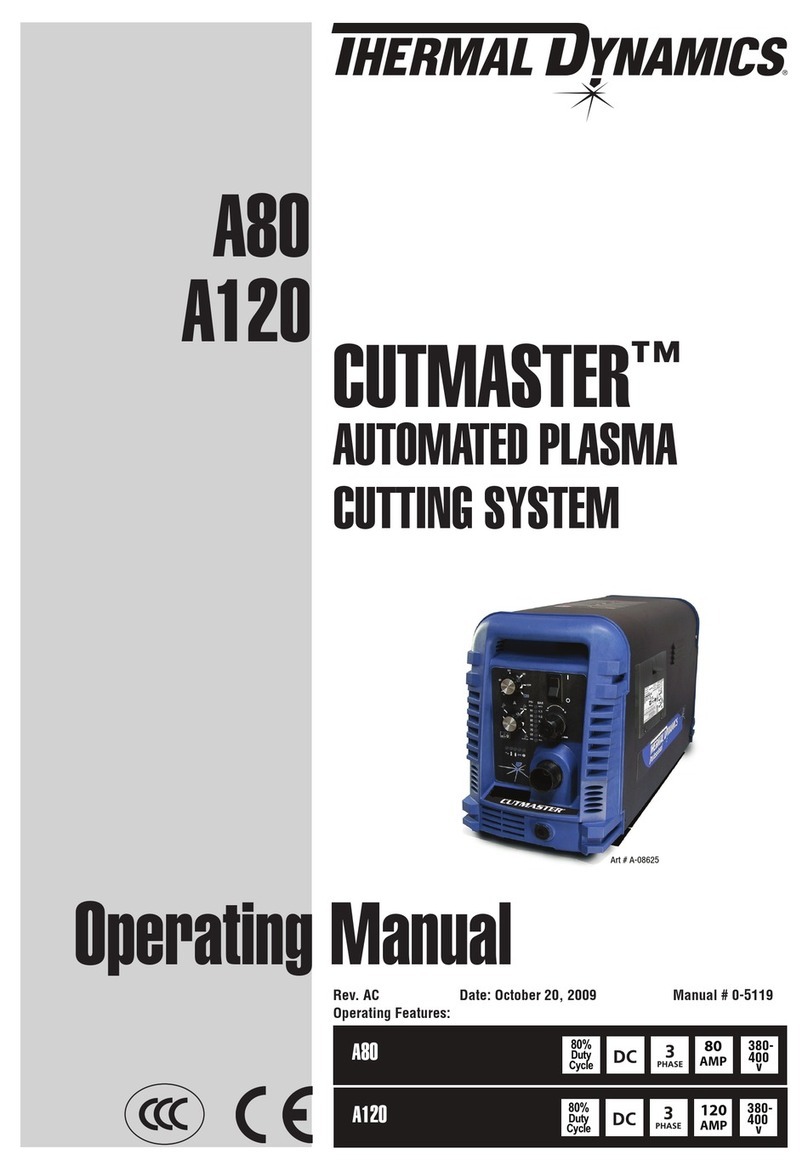
Thermal Dynamics
Thermal Dynamics A80 CUTMASTER User manual
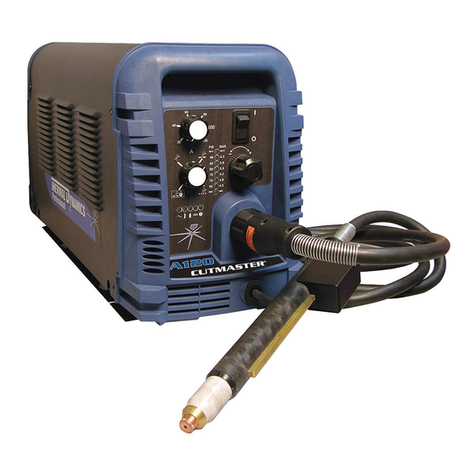
Thermal Dynamics
Thermal Dynamics A120 User manual
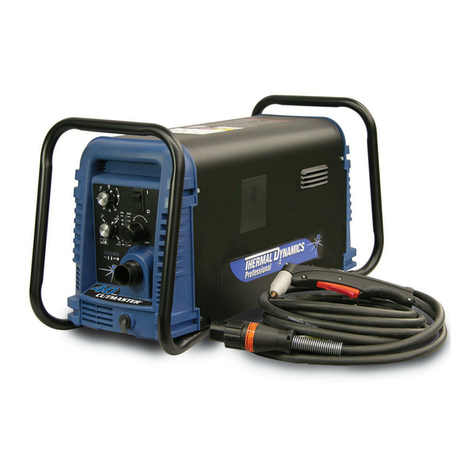
Thermal Dynamics
Thermal Dynamics CUTMASTER User manual
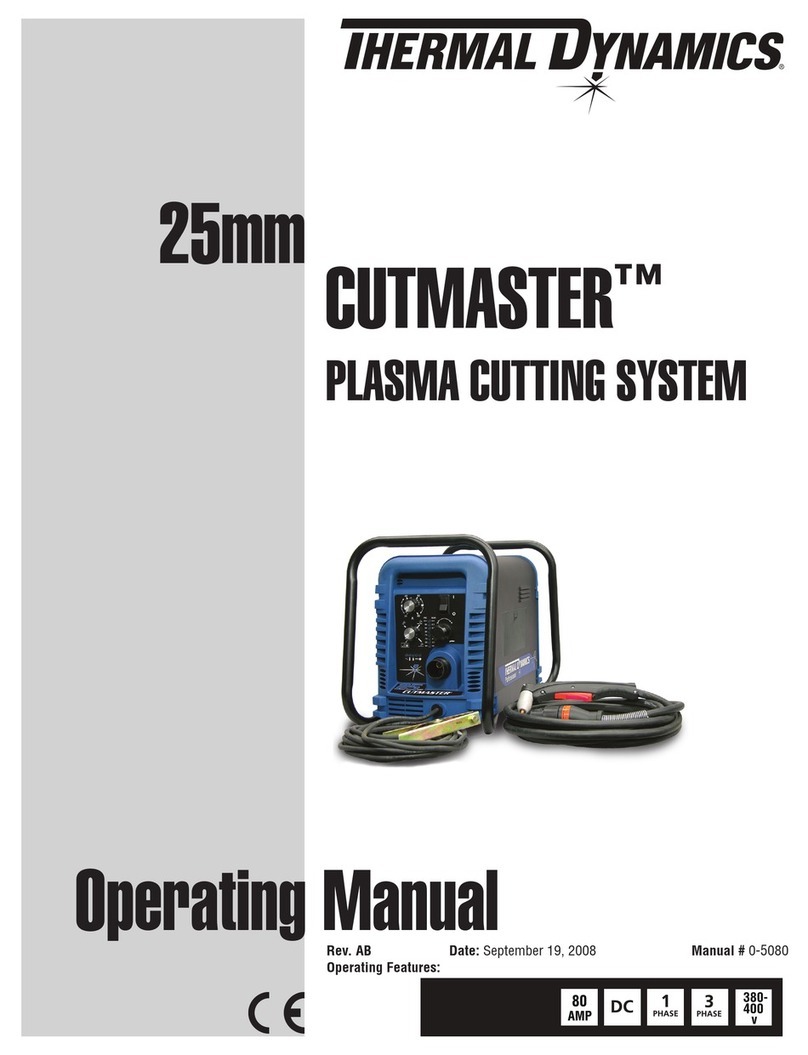
Thermal Dynamics
Thermal Dynamics CUTMASTER User manual
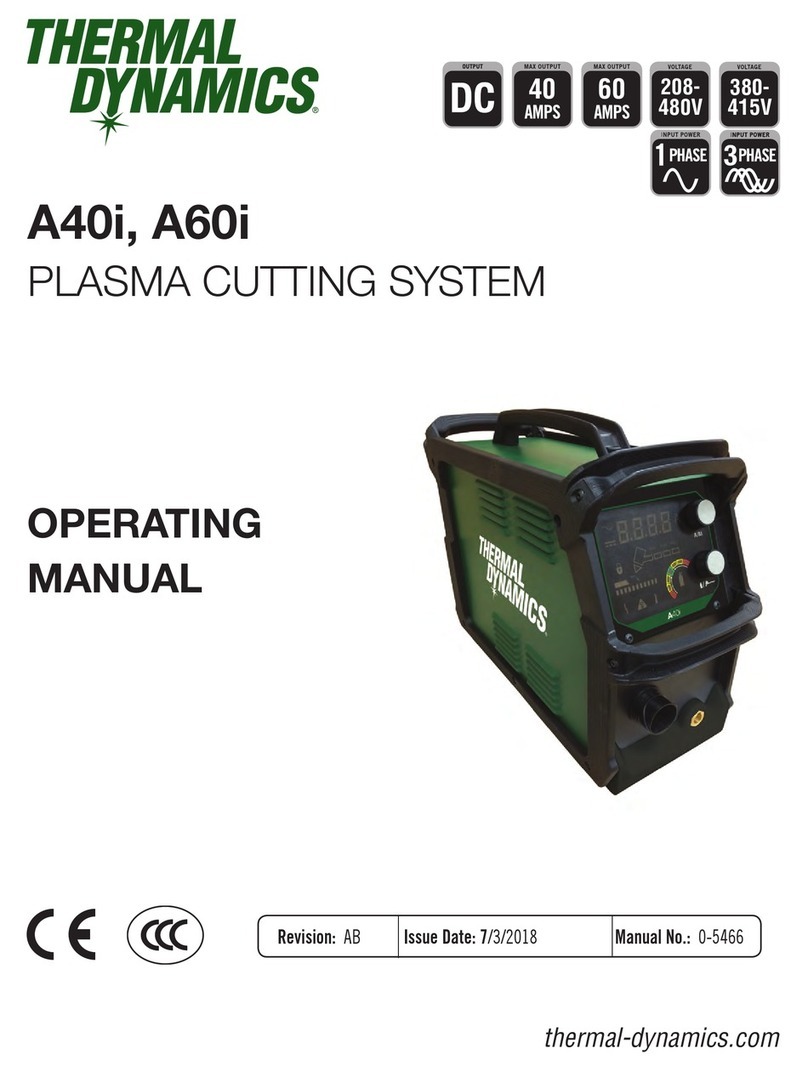
Thermal Dynamics
Thermal Dynamics A40i User manual
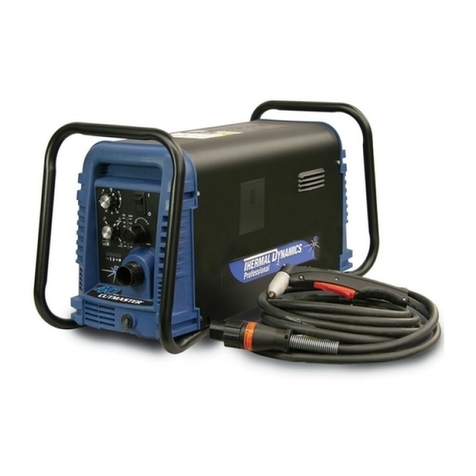
Thermal Dynamics
Thermal Dynamics CUTMASTER A-09206 User manual
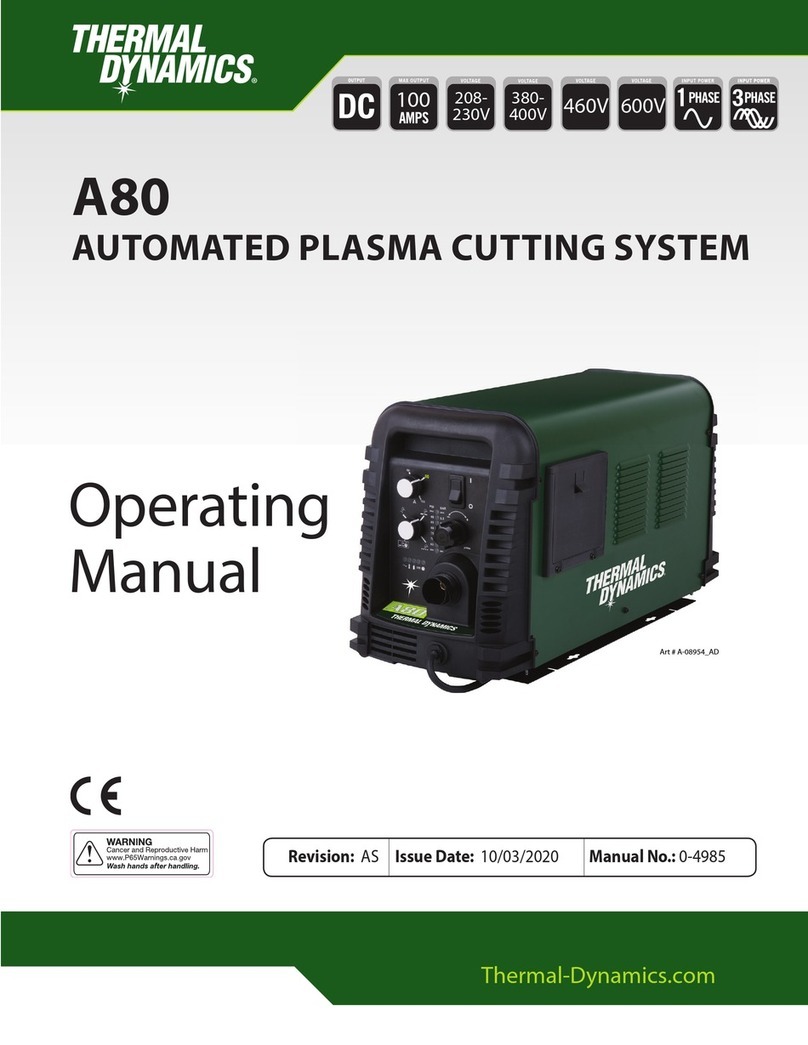
Thermal Dynamics
Thermal Dynamics A80 CUTMASTER User manual
Popular Cutter manuals by other brands

Silverline
Silverline 120001 manual
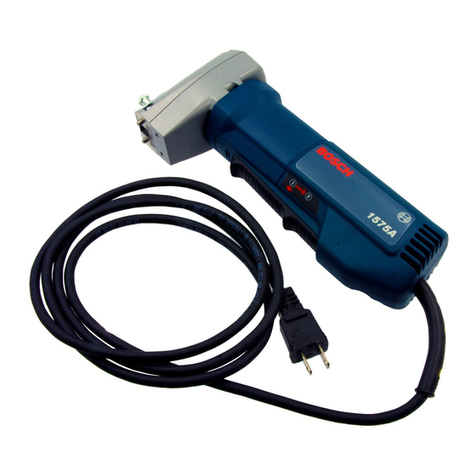
Bosch
Bosch 1575A Operating/safety instructions
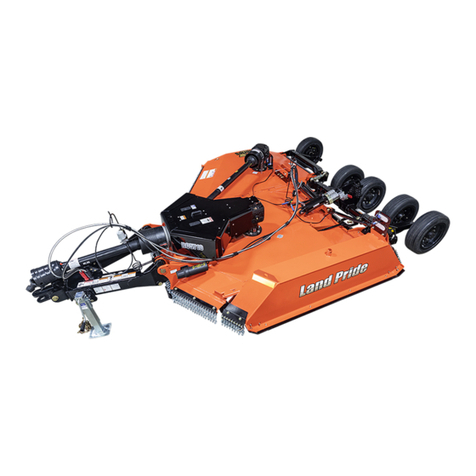
Land Pride
Land Pride RC5710 Operator's manual

Hilti
Hilti NCT 45 S-22 Original operating instructions

Hypertherm
Hypertherm HyPerformance Plasma HPR800XD instruction manual
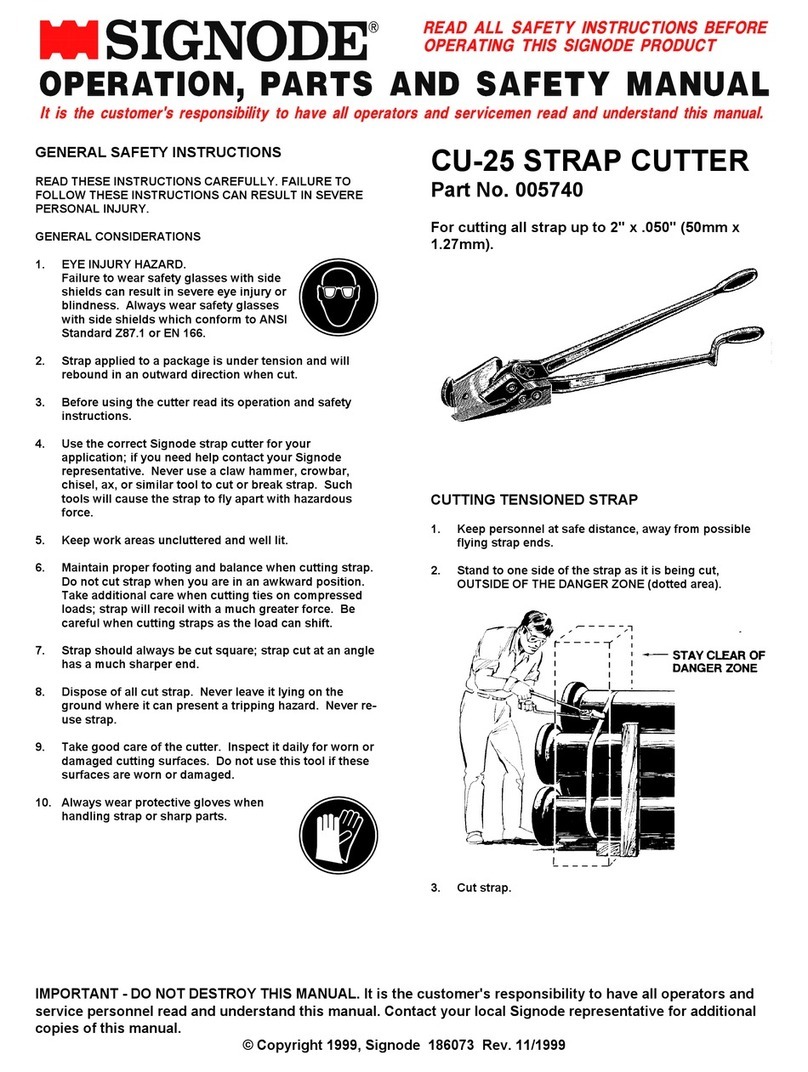
Signode
Signode CU-25 Operation, Safety and parts manual
